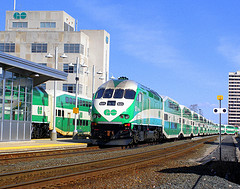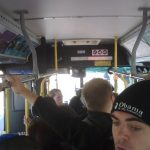Update, 2010-02-12: Guelph city council voted in December to retain the U-Pass program. Instead, reports the Guelph Tribune, students will be looking at a much more modest 33% increase in the price of their bus pass this year (around $20 per term) — assuming the increase is improved by a referendum. This proposal makes much more sense than the expensive opt-in pass that was originally proposed. Kudos to Guelph for recognizing the value of their U-Pass program.
The original post from December 7, 2009 follows.
TriTAG’s primary focus is transportation in Waterloo Region, but we are also interested in learning from other cities’ transportation issues.
Today I learned that Guelph Transit wants to scrap their popular universal bus pass program. The U-Pass is similar to the UW and Laurier bus pass programs. One of the first of its kind, it was introduced in 1994 and provides every University of Guelph student with unlimited transportation on Guelph Transit for $61.13 per term.
According to an article in The Cannon, students contribute a quarter of all Guelph Transit revenue — $2.2 million per year. Why, then, does Guelph Transit want to get rid of the U-Pass? Here is what Manager of Guelph Transit Michael Anders had to say:
Anders said he knew the change was “controversial” among students, and would result in an estimated 25 per cent drop in university student ridership. However, he said it was necessary because the current U of G rate is “way underpriced” and needs to be adjusted to reflect the costs of running transit.
Reading the article linked above, it seems that Guelph Transit hopes to raise $300,000 by scrapping the the U-Pass — at the cost of a quarter of the university’s transit ridership. Could there be a better way?
Given that students pay $61.13 per term and generate $2.2 million in revenue, it can be calculated that students account for around 36,000 pass-terms per year. At that figure, students could contribute an extra $300,000 to Guelph Transit if the price of the U-Pass were raised by $8.34 per term! I’m confident that an increase of under $10 per term would succeed easily if taken to referendum. And if the fee increase were not approved by students, Guelph Transit could still implement their current plan, which is to provide a more expensive optional student pass.
If the U-Pass were scrapped, student ridership would drop by 25%, and those students who continued to ride transit would pay many times what they pay now. Students would drive more, causing further congestion and parking headaches. Those who could not afford a car would be faced with the choice of an expensive bus pass or a loss of mobility. Guelph Transit would lose the guaranteed revenue provided by the U-Pass, replacing it with an uncertain revenue source that can’t be collected more than a month in advance.
It’s a pretty clear choice. I hope that Guelph councillors realize this and vote not to scrap the U-Pass.
Read More »






